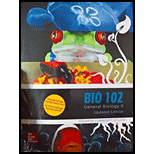
Concept explainers
Refer to the figure to answer these questions:
a. Add labels for mRNA (including the 5' and 3' ends) and tRNA. In addition, draw in the RNA polymerase enzyme and the ribosomes, including arrows indicating the direction of movement for each.
b. What are the next three amino acids to be added to polypeptide b?
c. Fill in the
d. What is the sequence of the DNA complementary to the template strand (as much as can be determined from the figure)?
e. Does this figure show the entire polypeptide that this gene encodes? How can you tell?
f. What might happen to polypeptide b after its re lease from the ribosome?
g. Does this figure depict a prokaryotic or a eukaryotic cell? How can you tell?
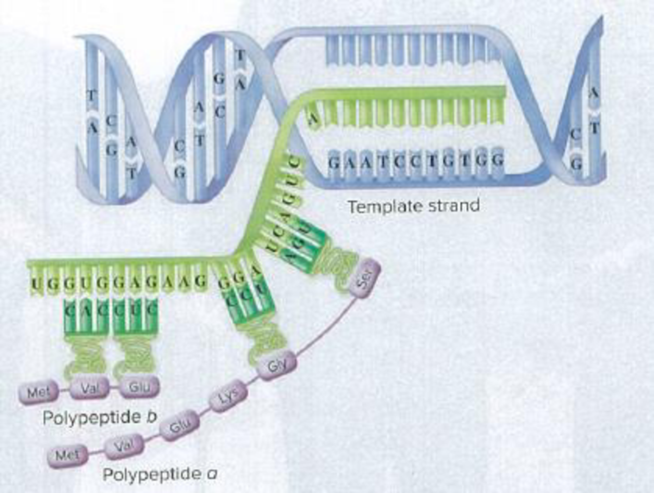
(a)
To add:
The labels for
Concept introduction:
A polypeptide chain is formed during the process of translation. In this process, the
Explanation of Solution
Pictorial representation: Fig.1: The nucleotide sequence
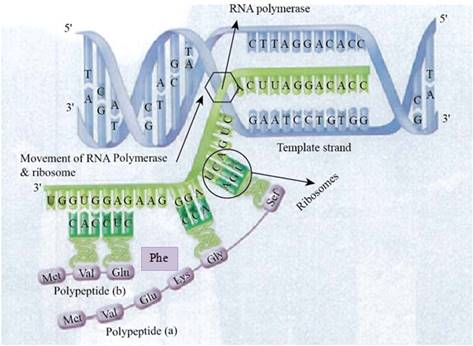
Fig.1: The nucleotide sequence.
Explanation:
The
(b)
To determine:
What are next three amino acids to be added in polypeptide b.
Concept introduction:
A polypeptide chain is formed during the process of translation. In this process, the
Explanation of Solution
Pictorial representation: Fig.1: The nucleotide sequence
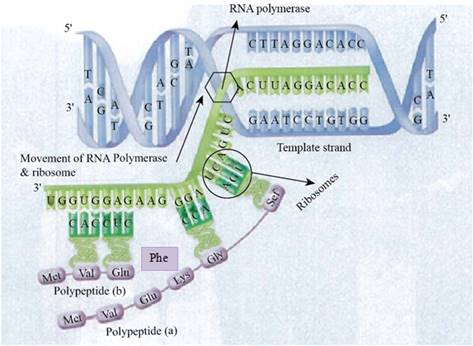
Fig.1: The nucleotide sequence.
Explanation:
Amino acid is an organic compound which serves as the basic building block of protein. It binds together with peptide bond to form protein, which performs specific function in body. It codes for amino acid methionine, serine and valine.
(c)
To fill:
The nucleotide in the
Concept introduction:
A polypeptide chain is formed during the process of translation. In this process, the
Explanation of Solution
Pictorial representation: Fig.1: The nucleotide sequence
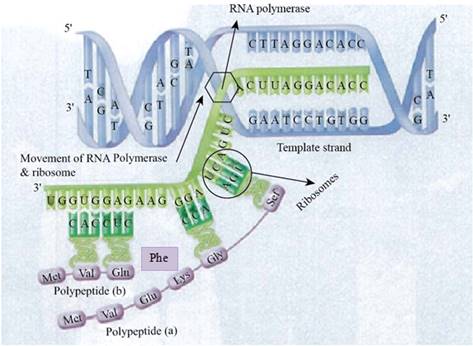
Fig.1: The nucleotide sequence.
Explanation:
The
(d)
To determine:
What is the sequence of DNA, which is complementary to the template strand.
Concept introduction:
A polypeptide chain is formed during the process of translation. In this process, the
Explanation of Solution
Pictorial representation: Fig.1: The nucleotide sequence
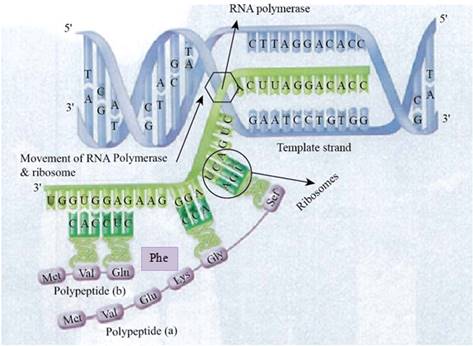
Fig.1: The nucleotide sequence.
Explanation:
The template DNA strand is
(e)
To determine:
Does this figure show the entire polypeptide that this gene encodes. How can you tell this.
Concept introduction:
A polypeptide chain is formed during the process of translation. In this process, the
Explanation of Solution
Pictorial representation: Fig.1: The nucleotide sequence
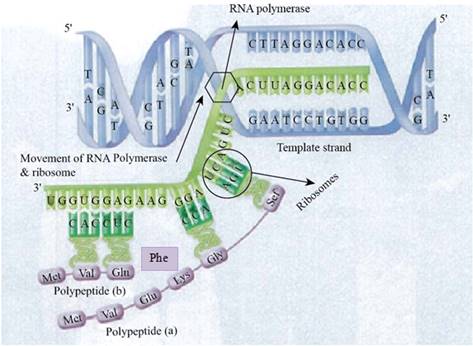
Fig.1: The nucleotide sequence.
Explanation:
No, this is not the entire polypeptide chain that is coded by gene because this chain only contains initiation codon such as
(f)
To determine:
What might happen to polypeptide b after it releases from ribosome.
Concept introduction:
A polypeptide chain is formed during the process of translation. In this process, the
Explanation of Solution
Pictorial representation: Fig.1: The nucleotide sequence
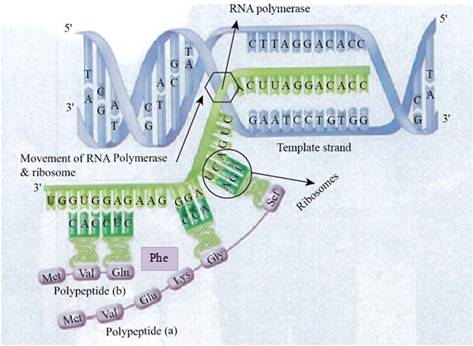
Fig.1: The nucleotide sequence.
Explanation:
When polypeptide b is released from ribosome, the process of protein synthesis is terminated and complete protein is synthesized and ready for gene expression. Ribosome helps in binding amino acids together to form a polypeptide chain.
(g)
To determine:
Does this figure depict the prokaryotic or eukaryotic cell. How can you tell.
Concept introduction:
A polypeptide chain is formed during the process of translation. In this process, the
Explanation of Solution
Pictorial representation: Fig.1: The nucleotide sequence

Fig.1: The nucleotide sequence.
Explanation:
This figure represents the prokaryotic cell because in prokaryotic cell, both the transcription and translation process occur simultaneously, while in eukaryotic cell, the transcription and translation processes occur at different space and time.
Want to see more full solutions like this?
Chapter 7 Solutions
BIO 102 General Biology II Updated Edition (Tidewater Community College)
Additional Science Textbook Solutions
General, Organic, and Biological Chemistry - 4th edition
Campbell Essential Biology (7th Edition)
HUMAN ANATOMY
Biology: Life on Earth with Physiology (11th Edition)
- What is this?arrow_forwardMolecular Biology A-C components of the question are corresponding to attached image labeled 1. D component of the question is corresponding to attached image labeled 2. For a eukaryotic mRNA, the sequences is as follows where AUGrepresents the start codon, the yellow is the Kozak sequence and (XXX) just represents any codonfor an amino acid (no stop codons here). G-cap and polyA tail are not shown A. How long is the peptide produced?B. What is the function (a sentence) of the UAA highlighted in blue?C. If the sequence highlighted in blue were changed from UAA to UAG, how would that affecttranslation? D. (1) The sequence highlighted in yellow above is moved to a new position indicated below. Howwould that affect translation? (2) How long would be the protein produced from this new mRNA? Thank youarrow_forwardMolecular Biology Question Explain why the cell doesn’t need 61 tRNAs (one for each codon). Please help. Thank youarrow_forward
- Molecular Biology You discover a disease causing mutation (indicated by the arrow) that alters splicing of its mRNA. This mutation (a base substitution in the splicing sequence) eliminates a 3’ splice site resulting in the inclusion of the second intron (I2) in the final mRNA. We are going to pretend that this intron is short having only 15 nucleotides (most introns are much longer so this is just to make things simple) with the following sequence shown below in bold. The ( ) indicate the reading frames in the exons; the included intron 2 sequences are in bold. A. Would you expected this change to be harmful? ExplainB. If you were to do gene therapy to fix this problem, briefly explain what type of gene therapy youwould use to correct this. Please help. Thank youarrow_forwardMolecular Biology Question Please help. Thank you Explain what is meant by the term “defective virus.” Explain how a defective virus is able to replicate.arrow_forwardMolecular Biology Explain why changing the codon GGG to GGA should not be harmful. Please help . Thank youarrow_forward
- Stage Percent Time in Hours Interphase .60 14.4 Prophase .20 4.8 Metaphase .10 2.4 Anaphase .06 1.44 Telophase .03 .72 Cytukinesis .01 .24 Can you summarize the results in the chart and explain which phases are faster and why the slower ones are slow?arrow_forwardCan you circle a cell in the different stages of mitosis? 1.prophase 2.metaphase 3.anaphase 4.telophase 5.cytokinesisarrow_forwardWhich microbe does not live part of its lifecycle outside humans? A. Toxoplasma gondii B. Cytomegalovirus C. Francisella tularensis D. Plasmodium falciparum explain your answer thoroughly.arrow_forward
- Select all of the following that the ablation (knockout) or ectopoic expression (gain of function) of Hox can contribute to. Another set of wings in the fruit fly, duplication of fingernails, ectopic ears in mice, excess feathers in duck/quail chimeras, and homeosis of segment 2 to jaw in Hox2a mutantsarrow_forwardSelect all of the following that changes in the MC1R gene can lead to: Changes in spots/stripes in lizards, changes in coat coloration in mice, ectopic ear formation in Siberian hamsters, and red hair in humansarrow_forwardPleiotropic genes are genes that (blank) Cause a swapping of organs/structures, are the result of duplicated sets of chromosomes, never produce protein products, and have more than one purpose/functionarrow_forward
 Human Heredity: Principles and Issues (MindTap Co...BiologyISBN:9781305251052Author:Michael CummingsPublisher:Cengage Learning
Human Heredity: Principles and Issues (MindTap Co...BiologyISBN:9781305251052Author:Michael CummingsPublisher:Cengage Learning Human Biology (MindTap Course List)BiologyISBN:9781305112100Author:Cecie Starr, Beverly McMillanPublisher:Cengage Learning
Human Biology (MindTap Course List)BiologyISBN:9781305112100Author:Cecie Starr, Beverly McMillanPublisher:Cengage Learning Concepts of BiologyBiologyISBN:9781938168116Author:Samantha Fowler, Rebecca Roush, James WisePublisher:OpenStax College
Concepts of BiologyBiologyISBN:9781938168116Author:Samantha Fowler, Rebecca Roush, James WisePublisher:OpenStax College Biology (MindTap Course List)BiologyISBN:9781337392938Author:Eldra Solomon, Charles Martin, Diana W. Martin, Linda R. BergPublisher:Cengage Learning
Biology (MindTap Course List)BiologyISBN:9781337392938Author:Eldra Solomon, Charles Martin, Diana W. Martin, Linda R. BergPublisher:Cengage Learning
 Biology Today and Tomorrow without Physiology (Mi...BiologyISBN:9781305117396Author:Cecie Starr, Christine Evers, Lisa StarrPublisher:Cengage Learning
Biology Today and Tomorrow without Physiology (Mi...BiologyISBN:9781305117396Author:Cecie Starr, Christine Evers, Lisa StarrPublisher:Cengage Learning





